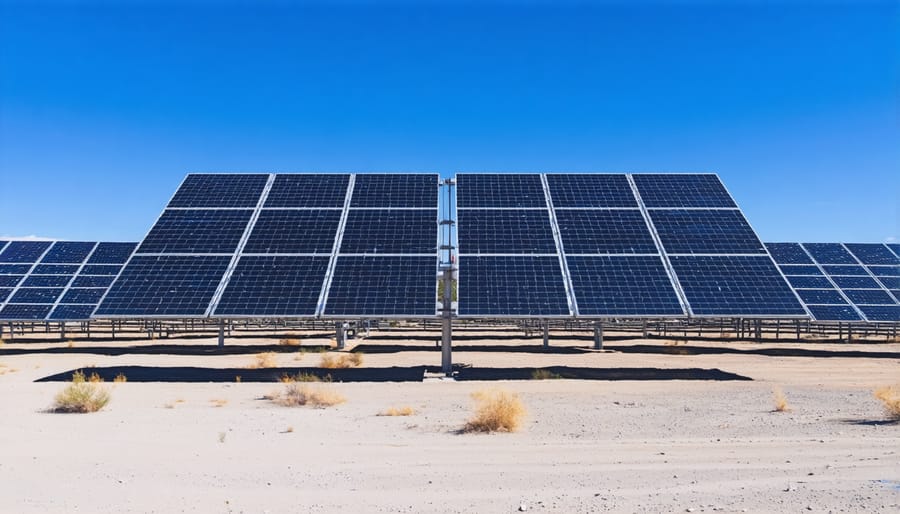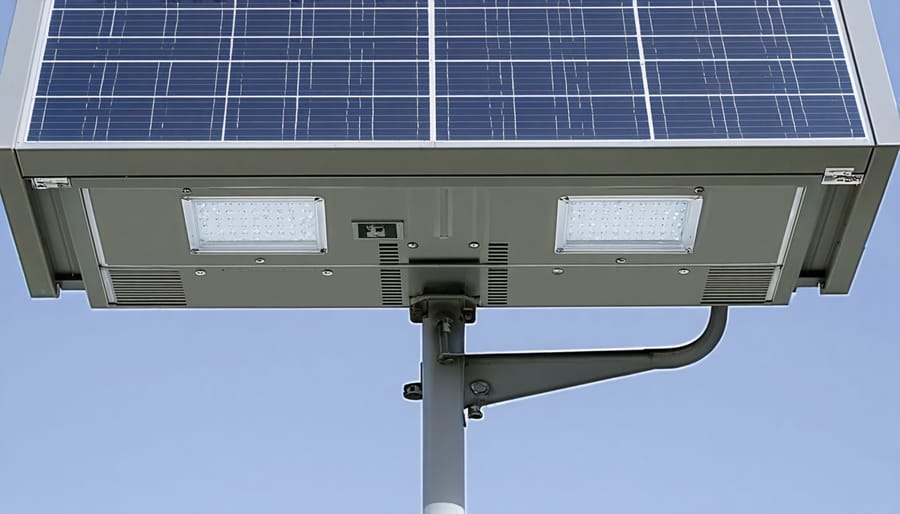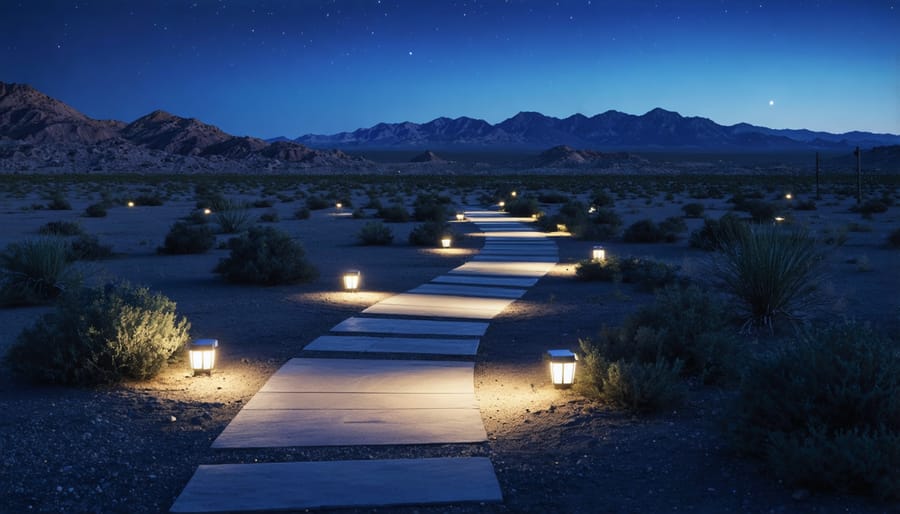Solar Desert Lighting That Actually Works (Even in Extreme Heat)
Desert lighting transforms harsh landscapes into stunning visual masterpieces while providing essential illumination for safety and functionality. As the sun sets over endless dunes and rocky terrain, solar powered lighting harnesses the desert’s most abundant resource, creating sustainable brilliance that defines modern desert living.
In these arid environments, where extreme temperatures and intense sunlight pose unique challenges, innovative lighting solutions are revolutionizing how we illuminate outdoor spaces. From residential pathways to commercial developments, desert lighting systems must balance durability against natural elements with the need for energy efficiency and aesthetic appeal.
The marriage of cutting-edge technology with environmental consciousness has opened new possibilities for desert illumination. By understanding the distinct characteristics of desert environments – from dust storms to temperature fluctuations – we can implement lighting solutions that not only survive but thrive in these demanding conditions. This guide explores how to master desert lighting, ensuring your installation delivers reliable, efficient, and breathtaking results in even the most challenging desert settings.
Why Desert Environments Are Perfect for Solar Lighting
Maximum Sun Exposure Benefits
Desert regions enjoy exceptional solar advantages, with up to 14 hours of direct sunlight during summer months and over 300 sunny days annually in many locations. This abundant sunshine delivers more intense rays due to the minimal cloud cover and lower humidity levels typical of desert climates. The sun’s position remains relatively high in the sky throughout the year, ensuring consistent exposure even during winter months.
What makes desert sunlight particularly valuable is its quality. The clear, dry air allows more solar radiation to reach the ground compared to humid regions, resulting in approximately 30% more energy potential per square foot of solar collection area. This increased intensity means desert-based solar installations can generate more power with smaller footprints.
These optimal conditions create perfect opportunities for both residential and commercial solar applications. Morning to evening sun exposure, combined with minimal interference from weather patterns, ensures reliable power generation throughout the day. Property owners can maximize this natural advantage by strategically positioning solar panels and lighting systems to capture the longest possible duration of direct sunlight.

Lower Cloud Coverage Impact
Desert regions are blessed with remarkably clear skies, making them ideal locations for solar energy collection. With minimal cloud coverage throughout the year, these areas receive consistent and intense sunlight that can be efficiently converted into reliable power. Unlike more temperate regions that experience frequent cloud cover, desert locations often enjoy over 300 sunny days annually, maximizing the potential for solar energy generation.
This abundance of clear skies means solar panels in desert environments can operate at peak efficiency for longer periods. During daylight hours, the unobstructed sunlight allows for steady energy collection, resulting in more predictable power output and better overall system performance. The minimal cloud interference also means that battery storage systems can be charged more consistently, ensuring a reliable power supply even after sunset.
For property owners, this translates to higher energy yields and faster returns on investment. The predictable nature of desert sunshine also makes it easier to calculate expected power generation and plan energy usage accordingly, leading to more effective system sizing and cost management.
Desert-Specific Solar Lighting Challenges
Heat Management Solutions
Maintaining optimal performance of solar lighting in desert conditions requires strategic heat management solutions. One of the most effective approaches is the implementation of heat-dissipating materials and designs. Advanced aluminum heat sinks and ventilation systems help prevent overheating, which can lead to common solar light issues and reduced efficiency.
Installing solar lights with adequate spacing and proper orientation can significantly improve airflow around the units. We recommend positioning lights at least three feet apart and ensuring they’re elevated from the ground to minimize heat absorption from the desert surface. Some modern desert-optimized solar lights feature special ceramic coatings that reflect excess heat while maintaining optimal light absorption.
Smart temperature monitoring systems are becoming increasingly popular in desert installations. These systems automatically adjust brightness levels during peak heat periods to prevent component stress and extend battery life. Additionally, incorporating shade structures or natural vegetation around solar light installations can create microenvironments that reduce ambient temperatures by up to 10 degrees Fahrenheit.
For maximum efficiency, consider using hybrid cooling solutions that combine passive and active cooling methods. This might include built-in fans that activate during extreme temperature spikes and thermally conductive mounting brackets that help dissipate heat through the support structure. Regular maintenance checks during cooler morning hours ensure optimal performance and early detection of heat-related issues.
Sand and Dust Protection
Protecting your solar lighting equipment from sand and dust is crucial for maintaining optimal performance in desert environments. A multi-layered approach works best, starting with proper positioning of your solar panels. Installing panels at a slight angle (typically 15-20 degrees) allows natural wind and rainfall to sweep away accumulated dust and sand.
Protective covers and enclosures designed specifically for desert conditions are your first line of defense. Look for IP65-rated or higher enclosures, which provide excellent protection against dust infiltration while allowing necessary ventilation. These enclosures should be installed with rubber gaskets to create a tight seal around all electrical components.
Regular cleaning is essential, but gentle methods are key. Use soft microfiber cloths and specialized solar panel cleaning solutions to avoid scratching the panels’ surface. For automated protection, consider installing dust sensors that trigger cleaning systems when accumulation reaches critical levels.
Anti-static coatings can significantly reduce dust adherence to panel surfaces. These modern solutions create a repellent layer that makes it harder for particles to stick and easier for wind to naturally clean the panels. Some newer models even feature self-cleaning nanotechnology that repels sand and dust particles.
Remember to check and clean any ventilation systems regularly, as these can become clogged with fine desert particles. Maintaining clean filters and airways ensures proper cooling of your lighting components, extending their lifespan in harsh desert conditions.

Best Solar Lighting Options for Desert Climates
Path and Landscape Lighting
Illuminating pathways and landscapes in desert environments requires thoughtful consideration of both functionality and aesthetics. Modern outdoor lighting solutions offer numerous options that complement the natural beauty of desert landscapes while providing essential visibility and security.
Low-voltage LED path lights are particularly effective for desert settings, as they consume minimal energy and withstand extreme temperatures. Position these fixtures every 6-8 feet along walkways and driveways to create safe passage while maintaining a subtle ambiance. Choose warm white lights around 2700K to minimize light pollution and preserve the desert’s spectacular night sky views.
For landscape lighting, consider uplighting desert plants to showcase their unique architectural forms. Palm trees, saguaros, and other native desert plants cast dramatic shadows when illuminated from below. Installing adjustable spotlights with glare shields helps direct light precisely where needed while protecting local wildlife from excessive artificial light.
Solar-powered bollard lights offer an eco-friendly option for marking pathway boundaries. These self-contained units store energy during the day and automatically activate at dusk, requiring no electrical infrastructure. Look for models with dust-resistant covers and UV-protected materials to ensure longevity in harsh desert conditions.
Integration of motion sensors can further enhance energy efficiency while providing additional security. These smart features ensure adequate lighting when needed while preserving the natural darkness desert environments are known for. Remember to position fixtures away from areas where sand and debris might accumulate, and consider using copper or brass materials that age gracefully in desert conditions.
Security and Flood Lighting
Security lighting in desert environments requires careful consideration of both effectiveness and sustainability. Solar-powered flood lights offer an excellent solution, combining robust security with energy efficiency. These high-powered fixtures typically feature motion sensors and adjustable brightness levels, making them ideal for protecting desert properties while minimizing light pollution.
For optimal security coverage, consider installing 2-3 flood lights for every 1,000 square feet of property. Modern solar security lights come equipped with advanced features like remote control operation, customizable scheduling, and emergency backup power. Many models now offer up to 10,000 lumens of brightness, sufficient to illuminate large areas even in complete darkness.
When selecting security lighting for desert installations, look for fixtures rated IP65 or higher for dust and sand protection. Heat-resistant materials and anti-corrosive coatings are essential features that ensure longevity in harsh desert conditions. LED technology is particularly suitable, as it generates minimal heat while providing maximum illumination.
Installation tip: Mount security lights at least 10-12 feet high and angle them slightly downward. This positioning maximizes coverage while reducing glare and light trespass onto neighboring properties. For enhanced effectiveness, integrate your security lighting with smart home systems for automated control and monitoring.
Desert property owners report significant success with dual-head flood lights that provide 180-degree coverage. These systems typically include high-capacity batteries that store enough power for 3-5 nights of operation, ensuring continuous security even during periods of limited sunlight. For commercial properties, consider supplementing flood lights with smaller pathway lights to create comprehensive security zones while maintaining an aesthetically pleasing appearance.
Installation and Maintenance Tips
Strategic Placement
Strategic placement of solar lights in desert environments can make the difference between optimal performance and mediocre results. Start by identifying high-traffic areas that need consistent illumination, such as walkways, entrances, and security zones. Position lights at least 8-10 feet apart to create overlapping light coverage without dark spots.
For maximum sun exposure, angle solar panels slightly toward the south if you’re in the Northern Hemisphere. A tilt of 30-45 degrees usually works best in desert regions, allowing natural dust and sand to slide off while capturing optimal sunlight. Avoid placing lights where they might be shadowed by buildings, trees, or other structures during peak solar collection hours (typically 10 AM to 3 PM).
Consider prevailing wind patterns when mounting your lights. In areas with strong desert winds, secure lights firmly and position them so the solar panels face away from the typical wind direction to minimize dust accumulation. For pathway lighting, stagger lights on alternating sides to create balanced illumination and reduce glare.
Remember to keep lights elevated in areas prone to sand drifts. Installing them on posts or mounting them on walls at least 3 feet above ground level helps prevent sand burial and maintains consistent performance. For security lighting, focus on corners and entry points, positioning motion sensors to cover approach angles effectively.

Desert-Proof Maintenance Schedule
Desert environments demand a rigorous approach to solar light maintenance to ensure optimal performance. We recommend following this monthly schedule to keep your lighting system in top condition:
Week 1: Clean solar panels thoroughly using a soft brush and distilled water to remove accumulated sand and dust. Avoid cleaning during peak sun hours to prevent water spots from forming.
Week 2: Inspect all wiring connections for signs of sun damage or cracking. Check that protective coverings remain intact and replace any deteriorated cable insulation.
Week 3: Test battery performance and charging capabilities. In desert conditions, batteries may require replacement more frequently due to extreme temperature exposure.
Week 4: Clean light fixtures and check for any sand accumulation in seals or gaskets. Look for signs of UV damage on plastic components.
Additional seasonal tasks include:
– Spring: Deep cleaning of all components before peak summer heat
– Summer: Additional panel cleaning during dust storm season
– Fall: System-wide inspection before shorter winter days
– Winter: Adjustment of light angles to maximize shorter daylight hours
Remember to document all maintenance activities and keep spare parts on hand, as desert conditions can accelerate wear and tear on components. Professional inspection is recommended annually to ensure system longevity.
Desert solar lighting represents a powerful fusion of sustainable technology and practical necessity. Throughout this guide, we’ve explored how solar-powered lighting solutions are revolutionizing the way we illuminate desert environments, offering both environmental and economic benefits. From reducing carbon footprints to slashing electricity bills, the advantages of solar lighting in desert regions are clear and compelling.
The abundant sunshine in desert areas makes these regions ideal for solar lighting applications, whether for residential pathways, commercial properties, or public spaces. We’ve seen how proper installation, strategic positioning, and regular maintenance can maximize the efficiency of solar lighting systems, ensuring they perform optimally even in challenging desert conditions.
While desert environments present unique challenges such as dust accumulation and extreme temperatures, these obstacles are easily overcome with proper planning and care. The testimonials from desert homeowners and businesses have shown that the initial investment in solar lighting quickly pays for itself through reduced energy costs and minimal maintenance requirements.
As we look to a more sustainable future, solar lighting in desert environments stands as a shining example of how we can harness natural resources effectively. Whether you’re a homeowner looking to illuminate your garden or a property manager seeking efficient lighting solutions, solar technology offers a reliable, cost-effective, and environmentally friendly option. Take the first step toward sustainable lighting today – your wallet and the planet will thank you.








